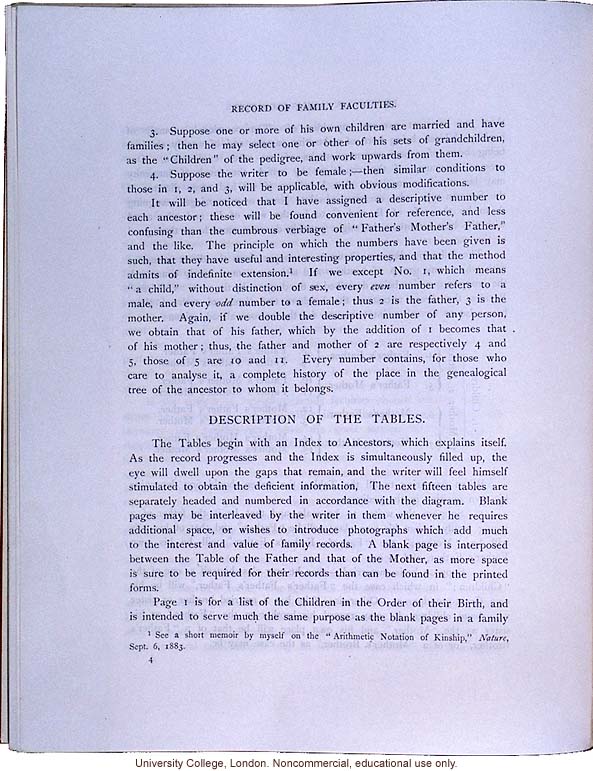Record of Family Faculties.
3. Suppose one or more of his own children are married and have families; then he may select one or other of his sets of grandchildren, as the "Children" of the pedigree, and work upwards from them.
4. Suppose the writer to be female;--then similar conditions to those in 1, 2, and 3, will be applicable, with obvious modifications.
It will be noticed that I have assigned a descriptive number to each ancestor; these will be found convenient for reference, and less confusing than the cumbrous verbiage of "Father's Mother's Father," and the like. The principle on which the numbers have been given is such, that they have useful and interesting properties, and that the method admits of indefinite extension.[superior 1] If we except No. 1, which means "a child," without distinction of sex, every [italics]even[end italics] number refers to a male, and every [italics]odd[end italics] number to a female; thus 2 is the father, 3 is the mother. Again, if we double the descriptive number of any person, we obtain that of his father, which by the addition of 1 becomes that of his mother; thus, the father and mother of 2 are respectively 4 and 5, those of 5 are 10 and 11. Every number contains, for those who care to analyse it, a complete history of the place in the genealogical tree of the ancestor to whom it belongs.
Description of the Tables.
The Tables begin with an Index to Ancestors, which explains itself. As the record progresses and the Index is simultaneously filled up, the eye will dwell upon the gaps that remain, and the writer will feel himself stimulated to obtain the deficient information. The next fifteen tables are separately headed and numbered in accordance with the diagram. Blank pages may be interleaved by the writer in them whenever he requires additional space, or wishes to introduce photographs which add much to the interest and value of family records. A blank page is interposed between the Table of the Father and that of the Mother, as more space is sure to be required for their records than can be found in the printed forms.
Page 1 is for a list of the Children in the Order of their Birth, and is intended to serve much the same purpose as the blank pages in a family
[footnote, superior1] See a short memoir by myself on the "Arithmetic Notation of Kinship," [italics]Nature,[end italics] Sept. 6, 1883.
4
[end]


